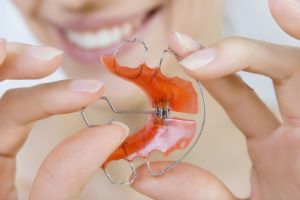 Crooked teeth, irregular bite, bulging fangs, diastema between the front teeth - all these features do not even color pretty young children.
Crooked teeth, irregular bite, bulging fangs, diastema between the front teeth - all these features do not even color pretty young children.
In order for the child to have a beautiful smile and even teeth in the future, parents need to be taken care of early, at an early age, having corrected problems with the jaw and bite.
Contents of
- Structure of orthodontic plates
- Varieties of children's correcting plates
- Removable and non-removable
- designs Advantages and disadvantages as two sides of the
- medal. VS braces
- .
- mounting and mounting procedure. Usage and care
- How to twist the plate?
- Other features of
- Parents have something to say
- How much does an
installation cost? The structure of orthodontic plates
Plates for teeth alignment are most often used in pediatric orthodontics, since up to fifteen years of gums are not so strong and it is possible to "move"to the right place and strengthen them there. The younger the child, the faster the alignment process will be.
What is characteristic for a child such a device will be more convenient than wearing a bracket system, due to the design of the plate - it is very simple, which makes it not only comfortable for use, but also cheap enough.
The plate consists of:
- basis : strong, but at the same time moderately stiff;
- metal elastic wire , which is bent into an arc and hooks, the correction of tension and which is the alignment of teeth;
- special mechanism in the base of the device and a small screwdriver , more like a needle to adjust the state of the plate.
Kinds of children's corrective plates
Depending on the nature of the problem and design, the bite correction plates are divided into different types:
- Brukle's apparatus is characterized by that it is used to correct defects of the lower jaw, anterior row of teeth.
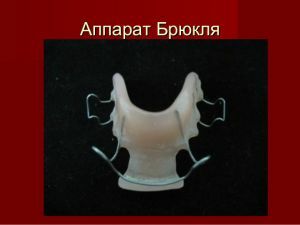
- Single-jawed - consists of a base, orthodontic screws, as a result of pulling which presses on specific teeth, which is what causes their alignment. It is used with a narrowed or shortened dentition, and deformation of individual teeth.
- Apparatus with pusher - suitable only for the upper row. It is used to correct the palatine position of the teeth with the help of spring mechanisms.
- Apparatus with a hand-shaped process - is used both for the upper and the lower jaw. A plate is used for separately standing teeth: a small process regulates the pressure on the necessary tooth, moving it in the right direction.
- Activator Andrez-Gojjda - works immediately on the lower and upper jaw, while correcting several defects at once.
- Apparatus with retraction arc - suitable for correcting the protrusive position of the teeth located in the upper row.
- The Frenkel's is the most complex design with many components. Corrects an incorrect bite.
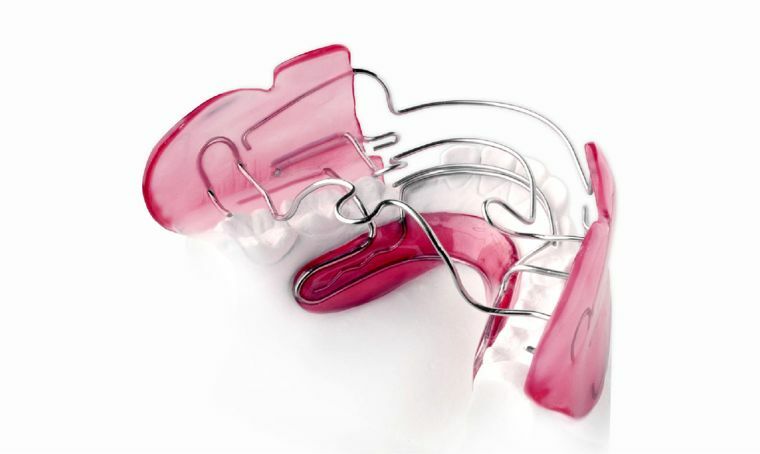
In the photo, the Frenkel's apparatus is one of the most difficult for the tooth plates
Removable and non-removable structures
Removable and non-removable plates are used to correct and correct tooth defects. The plates differ in their design, cost and effectiveness in correcting the problem.
Removable structures are made of quality hypoallergenic plastic, and attached to the jaws with the help of special metal hooks. The time of wearing such a device can be greater than that of a fixed model, but they also apply to correct minor effects.
Undeniable plus is the ability to remove the plate at any time: either to eat food, or to perform hygiene procedures.
If problems with the bite and the teeth are more serious, then in this case it is better to install non-removable plate models, the constant wearing of which will ensure maximum impact, and, consequently, a high and fairly fast result.
Advantages and disadvantages, as two sides of the medal
Wearing orthodontic plates for children has its advantages: 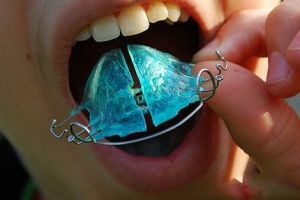
- qualitatively mounted plates are almost invisible;
- even a child will be able to take care of the apparatus;
- are simple and painless to install;
- fix defects in a fairly short time;
- removable models give an opportunity to rest for a couple of hours a day from the plates, taking them off for food intake, cleaning teeth;
- low cost.
The disadvantages are:
- not all the plates can help: it all depends on the complexity of the situation, the characteristics of the gum tissue, the age of the patient;
- serious defects are practically not corrected;
- requires constant monitoring when the child uses a removable plate: if the device is often removed, the result can and do not wait.
Plates VS braces
As a child, the skeleton of the skeleton is in the process of formation, so if the parents or an orthodontist noticed any abnormalities in the location of the teeth, it is necessary to install the plate, since the bracket system is not advised to use at an early age.
Until the age of twelve or fourteen, preference should always be given to the plates, which will fix the bite and hold the teeth in this position, fixing them in this way. The use of the same braces may lead to a disruption in the development of the osseous-skeleton.
Installation process
Installation of the plate and getting used to it is a matter of several days:
- According to the made in advance impression of the jaw and X-ray , the specialist makes an individual device, which will be installed on the next
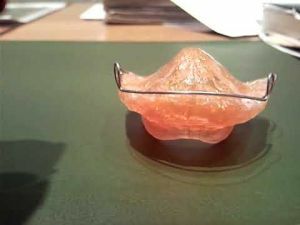 reception to correct the defects. Removable models are installed quickly, even the child himself can do it without the help of his parents.
reception to correct the defects. Removable models are installed quickly, even the child himself can do it without the help of his parents.
- The first installation procedure occurs necessarily in the presence of a physician. The child must understand: how to install the device correctly. The importance of the doctor's presence also lies in the fact that even a plate manufactured according to individual parameters can have small errors, which are immediately corrected by a specialist.
- The next step is getting used to .The plate is a foreign body for the body, so unpleasant sensations will manifest as pressure, pain, but all this is worth enduring for the sake of beautiful and smooth teeth in adulthood. The process of adaptation in each child can last quite differently: depending on the pain threshold, the characteristics of the teeth, gums, and psychological state. On the average, the addiction is from three to five days.
An important point is the quality care of the plate, which will avoid deformation and breakdown of the device.
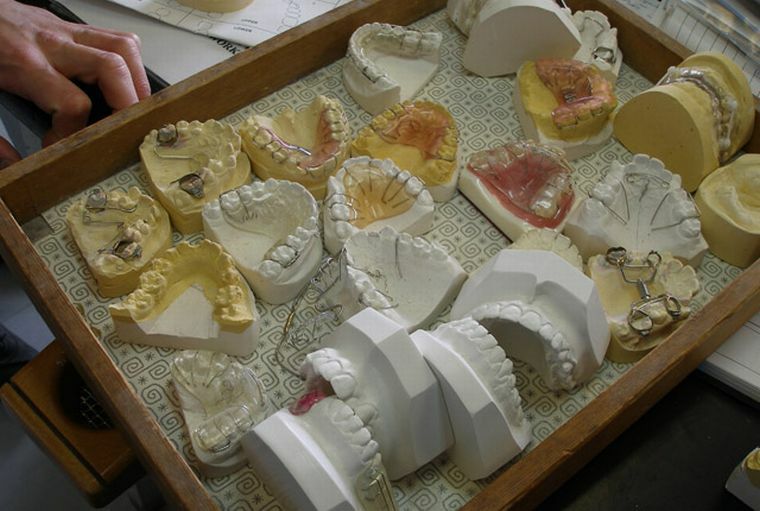
Usage and care
The process of wearing the plate from the first to the last day must be controlled by the parents, especially with regard to installed removable models.
So, for effective correction of defects, it is necessary to follow rules of wearing and care of plates:
- Do not remove for the night : the control of the parents in this matter should be maximum, especially at the time of getting used to the apparatus when the child is in pursuit of pain.
- Special attention should be paid to hygiene of the oral cavity of : except for ordinary teeth cleaning, during which the design is removed, it is necessary to treat the plate with a special brush and gel. You need to repeat this twice a day.
- To avoid contamination of the plate and its breakage, the should be removed for the duration of the food intake by the .
How to twist the plate?
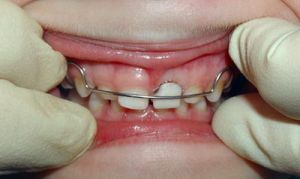 To increase the efficiency of correction of defects in teeth and bite, during the carrying out, it is necessary to screw the screw located on the base of the apparatus.
To increase the efficiency of correction of defects in teeth and bite, during the carrying out, it is necessary to screw the screw located on the base of the apparatus.
For this, it is necessary to remove the plate, and with the help of a key, make one complete revolution along the guide arrow. Thus, the load on the teeth and jaw will increase, and the process of repairing defects will accelerate.
After what time it is necessary to tighten the cog, you can tell the doctor who installs the device. This can be an interval of two weeks, a month, a half, depending on the speed of fixing the problem.
Other features of
A lot has been said about the effectiveness of wearing plates, but in what cases will they be relevant?
Which defects will help fix:
- jaw shape correction;
- change the position of the incisors in the row;
- slowing or acceleration of jaw growth associated with anomaly;
- enlarge or narrow the size of the palate.
Parents have something to say
The effectiveness of orthodontic plates can be judged by the responses of parents.
To the child of 11 years, the problem consisted in the fact that her fangs were pronounced and located much higher than other teeth. A month later, positive results were seen. After two - the teeth fell into place.
Anna, 36 years old
My son, after wearing a plate, had to wear the braces to fix the effect, but it was not for long, and the result we are happy with.
Maria, 42 years old
How much does the
cost? Placing a plate on a child's teeth is much cheaper than any bracket system. Even the cheapest braces are two to three times as expensive as the 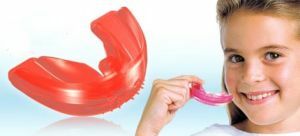 .
.
With regard to the specific price of the service, it can be different even within a single locality.
On average, the price is from 10 000 rubles( in Russia).
